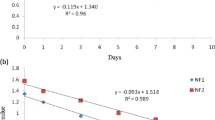Abstract
An experiment was conducted to evaluate the effects of some technological processes on the residual levels of profenofos, imidacloprid and penconazole in tomato fruits and products. According to their half-life (t ½) values, tomato fruits can be safely harvested for human consumption or for processing purposes 3 days after the spray time of imidacloprid and penconazole and 7 days after in the case of profenofos. Pesticide residues were greatly decreased in tomato juice under cold or hot break compared with that taken from unwashed tomato fruits. A sharp decline in profenofos level was noted after treatment by pectinex ultra SP-L and benzyme M during tomato crushing.

Similar content being viewed by others
References
Becker G, Schug P (1990) Miniaturized method for rapid determination of pesticide residues in foods of plant origin. Deutsche Lebensmittel-Rundschau 86:239–242
Dikshit AK, Pachaurý DC, Jindal T (2003) Maximum residue limit and risk assessment of etacyfluthrin and imidacloprid on tomato. Bull Environ Contam Toxicol 70:1143–1150
Faber K, Kroutil W (2005) New enzymes for biotransformation. Curr Opin Chem Biol 9:181–187
FAO/WHO (2008) Codex alimentarius. Pesticide residues in food. Maximum residue limits. 9 April Rome Italy
Gomaa EAA, Belal MH (1975) Determination of dimethoate residues in some vegetables and cotton plant. Zagazig J Agric Res 2:215–219
Holland PT, Hamilton D, Ohlin B, Skidmore MW (1994) Effects of storage and processing on pesticide residues in plant products. Pure Appl Chem 66:335–356
Khay S, Choi JH, Abd El-Aty MA (2008) Dissipation behavior of lufenuron, benzoylphenylurea insecticide, in/on Chinese cabbage applied by foliar spraying under greenhouse conditions. Bull Environ Contam Toxicol 81:369–372
Krause M, Loubser JT, De-Beer PR (1986) Residues of aldicarb and fenamiphos in soil. J Agric Food Chem 34:717–720
Lucke MA, Froberg JC, Masumato HT (1975) Extraction and cleaned up of organochlorine, organophosphate, organonitrogen and hydrocarbon pesticides in produce for determination by gas liquid chromatography. J Assoc Anal Chem 58:1020–1026
Luke MA, Doose GM (1983) A modification of the Luke multiresidue procedure for low moisture, non fatty products. Bull Environ Contam Toxicol 30:110–116
Osman T, Dilan B, Emine S, Gu¨ lizar A (2008) Testing the stability of pesticides during sample processing for the chlorpyrifos and malathion residue analysis in cucumber, including matrix effects. Bull Environ Contam Toxicol 80:38–43
Pilnik W, Voragen AG, Jen J (1989) Quality factors of fruits and vegetable Chemistry and Technology, p.250, ACS symposium series 405,Washington DC
Radwan MA, Abu-Elamayem MM, Shiboob MH, Abdel-Aal A (2005) Residual behavior of profenofos on some fieldgrown vegetables and its removal using various washing solutions and household processing. Food Chem Toxicol 43:553–557
Ramadan RA (1990) Residues of profenofos and pirimiphos methyl in tomato and okra fruits as influenced by certain technological processes. 4th Natural control of pests and diseases in vegetables and fruits in Egypt
Ripley BD, Edgington LV (1983) International and external plant residues and relationships to activity of pesticides. Plant protection for human welfare, 10th. International congress of plant protection (Croydon England British Crop Protection Council) 2:545–553
Sanyal N, Hazra D, Pal R, Somchaudhury AK, Chowdhury A (2006) Imidacloprid in processed tea and tea liquor. J Zhejiang Uni Sci B 7:619–622
Shokr SA, El-Hadidi MF, Abou-Zahw MM, Abdel-Razik M, Hegazy ME (1999) Residual behaviour of pirimicarp, fenthionand imidaclopride in broad bean and soil. Zagazig J Agric Res 26:1775–1783
Sohel D, Aparna S, Munishwar N (2007) A multipurpose immobilized biocatalyst with pectinase, xylanaseand cellulase activities. Chem Cent J 1:16
Sreenath HK, Santhanam K (1992) Comparison of cellulolytic and pectinolytic treatment of various fruit pulps. Chem Microbial Technol Lebensm 14:46–50
Author information
Authors and Affiliations
Corresponding author
Rights and permissions
About this article
Cite this article
Romeh, A.A., Mekky, T.M., Ramadan, R.A. et al. Dissipation of Profenofos, Imidacloprid and Penconazole in Tomato Fruits and Products. Bull Environ Contam Toxicol 83, 812–817 (2009). https://doi.org/10.1007/s00128-009-9852-z
Received:
Accepted:
Published:
Issue Date:
DOI: https://doi.org/10.1007/s00128-009-9852-z




